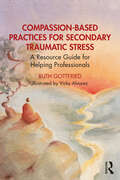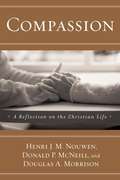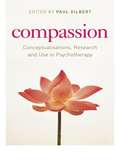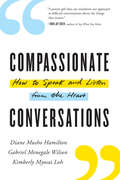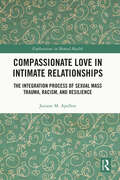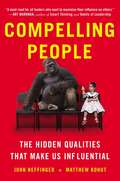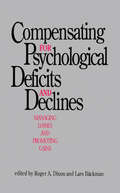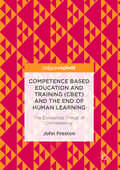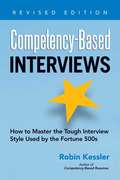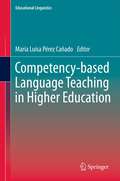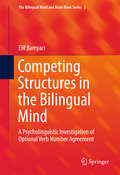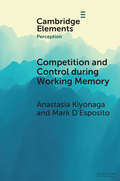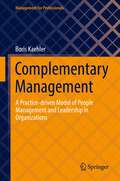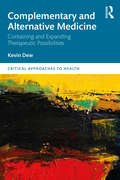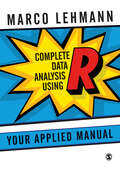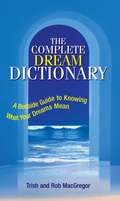- Table View
- List View
Compassion-Based Practices for Secondary Traumatic Stress: A Resource Guide for Helping Professionals
by Ruth GottfriedCompassion-Based Practices for Secondary Traumatic Stress is a comprehensive guide that merges profound theoretical insights with practical compassion-based practices. Tailored for helping professionals working with survivors of trauma, this book illuminates a path toward addressing secondary traumatic stress and promoting vicarious posttraumatic growth through a compassionate lens. Distinguished by its in-depth and hands-on creative approach, inclusion of East Asian philosophical principles, and harmonization of self- and other-oriented compassion, this resource guide provides empowering tools for helping professionals from diverse fields of practice and their host organizations.
Compassion: A Reflection on the Christian Life
by Henri J. M. Nouwen Donald P. Mcneill Douglas A. Morrison Joel FilartigaIn this provocative essay on that least understood virtue, compassion, the authors challenge themselves and us with these questions: Where do we place compassion in our lives? Is it enough to live a life in which we hurt one another as little as possible? Is our guiding ideal a life of maximum pleasure and minimum pain? Compassion answers no. After years of study and discussion among themselves, with other religious, and with men and women at the very center of national politics, the authors look at compassion with a vigorous new perspective. They place compassion at the heart of a Christian life in a world governed far too long by principles of power and destructive control. Compassion, no longer merely an eraser of human mistakes, is a force of prayer and action -- the expression of God's love for us and our love for God and one another. Compassion is a book that says no to a compassion of guilt and failure and yes to a compassionate love that pervades our spirit and moves us to action. Henri Nouwen, Donald McNeill, and Douglas Morrison have written a moving document on what it means to be a Christian in a difficult time.
Compassion: Concepts, Research and Applications
by Paul GilbertPaul Gilbert brings together an international line-up of leading scholars and researchers in the field to provide a state-of-the-art exploration of key areas in compassion research and applications. Compassion can be seen as a core element of prosocial behaviour, and explorations of the concepts and value of compassion have been extended into different aspects of life including physical and psychological therapies, schools, leadership and business. While many animals share abilities to be distress sensitive and caring of others, it is our newly evolved socially intelligent abilities that make us capable of knowingly and deliberately helping others and purposely developing skills and wisdom to do so. This book generates many research questions whilst exploring the similarity and differences of human compassion to non-human caring and looks at how compassion changes the brain and body, affects genetic expression, manifests at a young age and is then cultivated (or not) by the social environment. Compassion: Concepts, Research and Applications will be essential reading for professionals, researchers and scholars interested in compassion and its applications in psychology and psychotherapy.
Compassion: Conceptualisations, Research and Use in Psychotherapy
by Paul GilbertWhat is compassion, how does it affect the quality of our lives and how can we develop compassion for ourselves and others? Humans are capable of extreme cruelty but also considerable compassion. Often neglected in Western psychology, this book looks at how compassion may have evolved, and is linked to various capacities such as sympathy, empathy, forgiveness and warmth. Exploring the effects of early life experiences with families and peers, this book outlines how developing compassion for self and others can be key to helping people change, recover and develop ways of living that increase well-being. Focusing on the multi-dimensional nature of compassion, international contributors: explore integrative evolutionary, social constructivist, cognitive and Buddhist approaches to compassion consider how and why cruelty can flourish when our capacities for compassion are turned off, especially in particular environments focus on how therapists bring compassion into their therapeutic relationship, and examine its healing effects describe how to help patients develop inner warmth and compassion to help alleviate psychological problems. Compassion provides detailed outlines of interventions that are of particular value to psychotherapists and counsellors interested in developing compassion as a therapeutic focus in their work. It is also of value to social scientists interested in pro-social behaviour, and those seeking links between Buddhist and Western psychology.
Compassionate Conversations: How to Speak and Listen from the Heart
by Diane Musho Hamilton Gabriel Menegale Wilson Kimberly LohThe definitive guide to learning effective skills for engaging in open and honest conversations about divisive issues from three professional mediators.When a conversation takes a turn into the sometimes uncomfortable and often contentious topics of race, religion, gender, sexuality, and politics, it can be difficult to know what to say or how to respond to someone you disagree with. Compassionate Conversations empowers us to transform these conversations into opportunities to bridge divides and mend relationships by providing the basic set of conflict resolution skills we need to be successful, including listening, reframing, and dealing with strong emotions. Addressing the long history of injury and pain for marginalized groups, the authors explore topics like social privilege, power dynamics, and, political correctness allowing us to be more mindful in our conversations. Each chapter contains practices and reflection questions to help readers feel more prepared to talk through polarizing issues, ultimately encouraging us to take risks, to understand and recognize our deep commonalities, to be willing to make mistakes, and to become more intimate with expressing our truths, as well as listening to those of others.
Compassionate Love in Intimate Relationships: The Integration Process of Sexual Mass Trauma, Racism, and Resilience (Explorations in Mental Health)
by Josiane M. ApollonDrawing on interviews conducted with Black couples in the US, this book explores relational resilience and identifies unique adaptation strategies that enable couples to overcome the multigenerational effects of violence and sexual mass trauma from slavery and activates compassionate love in flourishing relationships. By applying Appreciative Inquiry (AI) methodology and family systems theory, the book captures the spiritual, emotional, and sexual dimensions in black couple systems that gives meaning to their resilient relationships in the context of contemporary America. Within the framework of compassionate love, the book highlights the need for researchers and clinicians to include the broader cultural contexts in their sexual trauma-informed studies and interventions. Using genetic studies and empirical evidence, the volume contributes significantly to discussion around Black relationships and historical trauma, and to the broader challenges within race relations in the United States. This book will benefit researchers, academicians, and clinicians with an interest in sexual trauma, marriage and family therapy, and couples counseling more broadly. Readers will also find this book useful when designing research in Black studies, intergenerational issues, or sexual intimacy.
Compelling People: The Hidden Qualities That Make Us Influential
by John Neffinger Matthew KohutHow People Judge You#151;And How To Come Out Looking Good Required Reading at Harvard Business School Everyone wants to know how to be more influential. But most of us don’t really think we can have the kind of magnetism or charisma that we associate with someone like Bill Clinton or Oprah Winfrey unless it comes naturally. Now, in Compelling People, which is already being taught at Harvard and Columbia Business Schools, John Neffinger and Matthew Kohut show that this isn’t something we have to be born with#151;it’s something we can learn. Expanding on the themes in their co-authored Harvard Business Review cover story #147;Connect, Then Lead,” they trace the path to influence through a balance of strength (the root of respect) and warmth (the root of affection). Each seems simple, but only a few of us figure out the tricky task of projecting both at once. The ability to master this dynamic is so rare that we celebrate and elevate those people who have managed to do it Drawing on cutting-edge social science research as well as their own work with Fortune 500 executives, members of Congress, TED speakers, and Nobel Prize winners, Neffinger and Kohut reveal: The common thread connecting Machiavelli and Martin Luther King The secret technique behind the success of Bill Clinton, Ann Richards and Denzel Washington#151;one that you can use today How looks affect our career prospects The single best strategy for getting someone to agree with you Compelling People explains how we size each other up#151;and how we can learn to win the admiration, respect, and affection we desire.
Compendium of Architectural Psychology: On the design of built environments (essentials)
by Antje FladeThis essential provides planning-relevant information on architectural psychology concepts and empirical results on the effects of built environments on people, and provides guidance on how to optimize the relationship between people and the built environment. This Springer essential is a translation of the original German 1st edition essentials, Kompendium der Architekturpsychologie by Antje Flade, published by Springer Fachmedien Wiesbaden GmbH, part of Springer Nature in 2020. The translation was done with the help of artificial intelligence (machine translation by the service DeepL.com). A subsequent human revision was done primarily in terms of content, so that the book will read stylistically differently from a conventional translation. Springer Nature works continuously to further the development of tools for the production of books and on the related technologies to support the authors.
Compensating for Psychological Deficits and Declines: Managing Losses and Promoting Gains
by Roger A. Dixon Lars BThe concept of compensation in psychology refers to processes through which a gap or mismatch between current accessible skills and environmental demands is reduced or closed. These gaps can be principally the result of losses, such as those associated with aging or interpersonal role changes; injuries, such as those that may occur to the neurological or sensory systems; organic or functional diseases, such as the dementias or schizophrenia; and congenital deficits, such as those apparent in autism or some learning disabilities. Whether the demand-skill gaps can be bridged completely, reduced only moderately, or are impossible to close, depends on a variety of factors. In every case, however, the guiding notions of compensation are that: * some such deficits may be amendable, * the continuation of the effects of the gap may be avoidable, and * some functioning may be recoverable. In this sense, compensation is related to adaptation; it is about overcoming deficits, managing the effects of losses, and promoting improvement in psychological functioning. Compensation is a concept that has a long and rich history in numerous domains of psychological research and practice. To date, however, few of the relevant research domains have benefitted explicitly or optimally from considering alternative perspectives on the concept of compensation. Although researchers and practitioners in several areas of psychology have actively pursued programs with compensation as a central concept, communication across disciplinary divides has been lacking. Comparing and contrasting the uses and implications of the concept across neighboring (and even not-so-adjacent) areas of psychology can promote advances in both theoretical and practical pursuits. The goal of this book is to carry inchoate integrative efforts to a new level of clarity. To this end, the editors have recruited major authors from selected principal areas of research and practice in psychological compensation. The authors review the current state of compensation scholarship in their domains of specialization. State-of-the-art reviews of this rapidly expanding area of scholarship are, therefore, collected under one cover for the first time. In this way, a wide variety of readers who might otherwise rarely cross professional paths with one another, can quickly learn about alternative preferences, agendas and methods, as well as novel research results, interpretations, and practical applications. Designed to contain broad, deep, and current perspectives on compensation, this volume continues the processes of: * explicating the concept of compensation; * linking and distinguishing compensation from neighboring concepts; * describing the variety of compensatory mechanisms operating in a wide range of phenomena; and * illustrating how compensatory mechanisms can be harnessed or trained to manage losses or deficits and to promote gains or at least maintenance of functioning.
Competence Based Education and Training (CBET) and the End of Human Learning: The Existential Threat of Competency
by John PrestonThis book radically counters the optimism sparked by Competence Based Education and Training, an educational philosophy that has re-emerged in Schooling, Vocational and Higher Education in the last decade. CBET supposedly offers a new type of learning that will lead to skilled employment; here, Preston instead presents the competency movement as one which makes the concept of human learning redundant. Starting with its origins in Taylorism, the slaughterhouse and radical behaviourism, the book charts the history of competency education to its position as a global phenomenon today, arguing that competency is opposed to ideas of process, causality and analog human movement that are fundamental to human learning.
Competence and Self-Care in Counselling and Psychotherapy
by Gerrie HughesWhat is it that makes a counsellor or psychotherapist competent? In Competence and Self-Care in Counselling and Psychotherapy, Gerrie Hughes offers a framework for understanding what being competent means for individual practitioners, both generally and in moment-by-moment work with clients. Divided into two sections, Part One, The Competent Self, and Part Two, Care of the Self, the book explores care and replenishment of the self as an essential requirement for maintaining competence. The Competence Framework presented here suggests that the three elements of Practitioner, Client and Context are essential factors for making good therapeutic choices, as well as offering a structure for reflection, either individually or in supervision. The eight principles that elaborate on these elements provide a route to explore competence that is relevant for any theoretical orientation and appropriate for practitioners at any stage. The reader is encouraged to make their own exploration of a number of factors that influence competence and to identify development of the self as both a necessary preparation for therapeutic work and as a continuing outcome of being a therapist. In addition, Hughes emphasises the importance of having a sound ethical framework and utilising professional structures as well as examining the contribution of supervision to the development and maintenance of competence. This book is an ideal choice for counsellors, psychotherapists, supervisors and trainers who wish to maintain a robust standard of practice, and for those employing them.
Competency Mapping and Assessment: A Practitioner's Handbook
by Seema SanghiThis book provides an in-depth coverage on competency mapping and assessment centre and includes an extensive list of generic competencies, competency models for HR, leadership, model for future competency, automobile sector, and academic institutions and experiences of some consultancy assignments. It presents the complete know-how of developing a competency framework in detail for all practitioners and professionals. The volume examines ‘what, why, how’ on the subject and extensive support models that have been developed over years of research, consultancy, and training experience across private, public, and government sectors in India, Bangladesh, Saudi Arabia, Nepal, the UK, and other countries. The book has been designed to help scholars and practitioners to understand, develop, manage, and map competencies with their organizations. The chapters are illustrated with figures and tables, along with examples, for a better understanding. The glossary of job task analysis will be helpful in job analysis, which is one of the most important tasks in developing competency models.The volume would be useful to both the academic and corporate world. The students, researchers, and faculty of business management courses, especially those specializing in human resource management, will have an in-depth understanding of ‘What and Why’ of competency frameworks, models, and assessment centre. It will be an essential resource for corporates—public and private sectors—multinational organizations, staff training institutions, learning and development centres, consultancy firms, trainers, government and public service organizations, etc. to get a hands-on understanding of ‘How’ of developing competency framework, competency mapping and assessment centre in their organizations.
Competency-Based Interviews: How to Master the Tough Interview Style Used by the Fortune 500s (Competency-based Ser.)
by Robin KesslerPeople interviewing for jobs today often fail because they are using yesterday's strategies. Technology is becoming more sophisticated and virtual assessment centers are being used to assess how strong candidates are in key competency areas. Global competencies are being used to help organizations choose people for international assignments or simply to work on diverse international teams. The best employers are constantly changing the way interviews are done. This newly revised edition of Competency-Based Interviews offers you a new and more effective way to handle the tough new interviews so that you will emphasize the knowledge, skills, and abilities that you have and that employers demand. <P><P> Preparing for a competency-based interview will give you the strategy you need to: <li>Be selected for the most competitive positions <li>Win the best job at a new organization <li>Get a great first job or internship <li>Be chosen for that critical promotion in your current organization <li>Take control of your career path <li>Increase your salary <li>Secure more interesting assignments and more interesting work
Competency-based Language Teaching in Higher Education (Educational Linguistics #14)
by María Luisa Pérez CañadoSpanning the divide between the theory and praxis of competency-based teaching in tertiary language education, this volume contains invaluable practical guidance for the post-secondary sector on how to approach, teach, and assess competencies in Bologna-adapted systems of study. It presents the latest results of prominent European research projects, programs of pedagogical innovation, and thematically linked academic networks. Responding to a profound need for a volume addressing the practical aspects of the newly designed language degrees now being rolled out across Europe, this essential contribution pools the insights of a prestigious set of scholars, practitioners, and policy makers from diverse parts of Europe and the US. It will inform crucial decisions about instituting and evaluating competencies in a new generation of language studies programmes.
Competent Reader, Disabled Reader: Research and Application (Psychology Revivals)
by Martin H. SingerIn the past frustration with experimental reports had caused educators to dismiss the entire reading research enterprise. Originally published in 1982, this book attempts to abstract those experimental results relevant to developing effective reading programs. The book concentrates on the more mechanical aspects of reading skill such as visual discrimination ability, visual and auditory memory, visual-to-phonetic translation skills, and attentional strategies. These skills it is argued, account for the major proportion of variance in reading ability. The research on both competent and incompetent reading indicates the special importance of such skills to reading. The book contains three sections. Section I reviews the experimental evidence on competent reading. The review highlights consistent threads of evidence and provides a description of the competent reader’s strategies for analyzing text. Section II reviews research on poor reading. This section evaluates the concept of dyslexia and stresses that reading problems are not uniform. Section III maintains that the information about competent reading strategies and the impediments to acquiring those strategies should guide educators in evaluating instructional materials and facilitate the diagnosis of reading failure. Today it can be read in its historical context.
Competing Structures in the Bilingual Mind: A Psycholinguistic Investigation of Optional Verb Number Agreement (The Bilingual Mind and Brain Book Series #2)
by Elif BamyacıThis volume combines psycholinguistic experiments with typological investigations in order to provide a comprehensive exploration of the linguistic structure of verb-number agreement in bilingual speakers, with a particular focus on the Turkish language. It takes as its starting point the question of which linguistic structures pose difficulties for bilingual speakers, and then proceeds to evaluate the question by using the interface phenomenon of optional verb number agreement. In doing so, this volume investigates how the bilingual mind handles grammatical structures that demand high processing sources, working towards a processing-based linguistic framework for the bilingual mind. Beginning with a thorough survey of the current research of the interface phenomenon in the bilingual mind, the volume then proceeds to present two separate studies on each linguistic interface type, namely semantics-syntax interface and syntax-pragmatics interface, thus filling a number of gaps in the bilingualism research with regards to the interface phenomenon The results and conclusions of these studies are then integrated with current knowledge and research from the field within a theoretical and processing-based framework in order to explore new psycholinguistic insights for the bilingual mind, specifically the conclusion that the grammar of bilingual speakers is shaped according to cross linguistic tendencies. Ultimately, it provides a unified account and a comprehensive conclu sion regarding the non-native-like patterns in grammar of bilingual speakers. Serving as a fascinating and timely resource, Competing Structures in the Bilingual Mind: An Investigation of Optional Verb Number Agreement will appeal to bilingualism researchers, clinical linguists, cognitive scientists, experimental linguists, and any linguist specializing in Turkic or Altaic languages.
Competition and Control during Working Memory (Elements in Perception)
by Anastasia Kiyonaga Mark D'EspositoWorking memory and perceptual attention are related functions, engaging many similar mechanisms and brain regions. As a consequence, behavioral and neural measures often reveal competition between working memory and attention demands. Yet there remains widespread debate about how working memory operates, and whether it truly shares processes and representations with attention. This Element will examine local-level representational properties to illuminate the storage format of working memory content, as well as systems-level and brain network communication properties to illuminate the attentional processes that control working memory. The Element will integrate both cognitive and neuroscientific accounts, describing shared substrates for working memory and perceptual attention, in a multi-level network architecture that provides robustness to disruptions and allows flexible attentional control in line with goals.
Competition in Second Language Classrooms: Causes, Consequences, and Implications (Second Language Learning and Teaching)
by Nourollah ZarrinabadiThis book offers an in-depth exploration of the causes and consequences of competition among language learners, with a particular focus on understanding the intricate relationships between competitiveness, beliefs about competition, and other psychological variables pertinent to language learning, such as motivation, anxiety, and mindsets. The initial chapters provide a comprehensive review of various competition theories and the latest empirical research on competition across diverse domains, including education and the workplace. Subsequently, the book qualitatively investigates the linguistic, psychological, educational, cultural, and contextual factors that contribute to competition in English language classrooms. It also delves into the potential psychological, educational, and personal outcomes of such competition in second language (L2) learning environments. Furthermore, this monograph scrutinizes the interplay between competition-related variables and the motivational and emotional dimensions of L2 learning. In its concluding sections, the book offers practical insights for language educators, guiding them on how to effectively manage competition among students to mitigate its adverse effects while leveraging its potential to enhance language learning and development.
Complaints and Grievances in Psychotherapy: A Handbook of Ethical Practice
by Fiona Palmer Barnes Fiona Palmer BarnesWhat is good practice when handling a complaint? What is the ethical basis of such practice? Fiona Palmer-Barnes pays equal attention to both these issues which are essential for psychotherapists and counsellors practising today. Drawing on her considerable experience of managing complaints for both the British Association for Counselling and the United Kingdom Council for Psychotherapy, she delineates the basics for putting in place a professional and ethical system of investigation and action. Illustrated by case examples, the handbook covers all aspects of complaints and grievance management: * competence * contract * confidentiality * mistakes or malpractice * principles for dealing with complaints * investigation * adjudication * sanctions * outcomes * appeals It includes useful addresses, current codes of ethics from major umbrella organizations, protocols and sample letters.
Complementary Management: A Practice-driven Model of People Management and Leadership in Organizations (Management for Professionals)
by Boris KaehlerThis book explores the Complementary Management Model. Building on extensive theoretical considerations on management and leadership, it outlines the seven elements of the model: the management actors (1) jointly fulfil management tasks (2) serving two management functions (3) by performing management routines (4) and applying formal management instruments (5), which requires management resources (6) and management unit structures (7). The key mechanisms of Complementary Management include the primacy of employee self-leadership, compensatory interventions of the line manager in the absence of such self-steerage, and active roles for senior managers and HR advisors in the management/leadership process. The Complementary Leadership Model is practice-oriented and offers a coherent conceptual basis for corporate models (= principles and guidelines) of management and leadership. The book describes the process for developing and introducing such guidelines and backs this up with project recommendations. It is aimed at all those interested in theory, but especially HR professionals and managers who shape management and leadership in their organizations and are looking for compelling theoretical foundations for their work.
Complementary and Alternative Medicine: Containing and Expanding Therapeutic Possibilities (Critical Approaches to Health)
by Kevin DewComplementary and Alternative Medicine is a sociological investigation of complementary and alternative medicine (CAM) in contemporary society, and an exploration of the forces throughout the globe, across different institutions, and within different therapeutic spaces, that constrain or foster alternative medicine. Drawing on 30 years of research, the book identifies the trends in the use of CAM and explores the scientific, political and social challenges that CAM faces in relation to orthodox medicine. The author examines the varieties of CAM practices and how they manifest in different institutional spaces – including public inquiries, the orthodox medical practitioner’s consulting room, medical journals and the homes of those who use CAM. It also compares unorthodox practices in different geo-political settings, namely the global north and the global south. This book is valuable reading for higher-level undergraduate and postgraduate social science students, including those in psychology, sociology, anthropology, health sciences and related disciplines. It is relevant for courses in medical sociology, medical anthropology and social science and health, and a broader audience interested in contemporary health issues, controversies and alternative medicine.
Complete Data Analysis Using R: Your Applied Manual
by Marco LehmannThis step-by-step guide shows you how to use R to get data analysis right. The book explores the entire process of analysis, covering key steps from preparing your data to putting your analysis together and writing up your findings. It helps you get to grips with doing different statistical techniques in R and: Equips you with practical data visualisation tools to create graphs and tables. Shows you how to prepare and present your research for assessment, publication and dissemination. Covers key issues facing today’s social scientists, such as making research reproducible. Features include an introduction to each chapter, and end-of-chapter exercises to check your understanding of the material. The online resources for this text include data sets that you can perform your own analysis on, and links to publications that are relevant to programming with R. A good starting point for any postgraduate student conducting a research project, this book will help you develop your statistics and programming knowledge and get quickly up to speed.
Complete Data Analysis Using R: Your Applied Manual
by Marco LehmannThis step-by-step guide shows you how to use R to get data analysis right. The book explores the entire process of analysis, covering key steps from preparing your data to putting your analysis together and writing up your findings. It helps you get to grips with doing different statistical techniques in R and: Equips you with practical data visualisation tools to create graphs and tables. Shows you how to prepare and present your research for assessment, publication and dissemination. Covers key issues facing today’s social scientists, such as making research reproducible. Features include an introduction to each chapter, and end-of-chapter exercises to check your understanding of the material. The online resources for this text include data sets that you can perform your own analysis on, and links to publications that are relevant to programming with R. A good starting point for any postgraduate student conducting a research project, this book will help you develop your statistics and programming knowledge and get quickly up to speed.
Complete Dream Dictionary
by Rob Macgregor Trish MacgregorIf you've ever wondered why nightmarish spiders spook you or why you have such vivid dreams of losing your teeth, read on. Filled with detailed background information and an alphabetical listing of symbols, The Complete Dream Dictionary shows you how to pick up on broad context clues as well as decipher the deeper meaning of specific images that appear in your dreams.The Complete Dream Dictionary helps you:Improve your dream recall and incubationSpot the metaphors, puns, and archetypes in your dreamsRecognize common as well as advanced dream typesCreate your own personal journal to record dream detailsUnderstand common dream themes, including flying, being chased, or giving birthExamine particular symbols in your dreams - from flowers to family membersWhether you're delving into recurring themes such as falling, or simply wondering what an apple or an airport means in your dream, The Complete Dream Dictionary shows you how to put these subconscious messages to good use in your waking life.
Complete Psychology
by Andy Field Graham Davey Ian Albery Chris Sterling Christopher SterlingThe new edition of Complete Psychology is the definitive undergraduate textbook. It not only fits exactly with the very latest BPS curriculum and offers integrated web support for students and lecturers, but it also includes guidance on study skills, research methods, statistics and careers. Complete Psychology provides excellent coverage of the major areas of study . Each chapter has been fully updated to reflect changes in the field and to include examples of psychology in applied settings, and further reading sections have been expanded. The companion website, www.completepsychology.co.uk, has also been fully revised and now contains chapter summaries, author pages, downloadable presentations, useful web links, multiple choice questions, essay questions and an electronic glossary. Written by an experienced and respected team of authors, this highly accessible, comprehensive text is illustrated in full colour, and quite simply covers everything students need for their first-year studies as well as being an invaluable reference and revision tool for second and third years.
